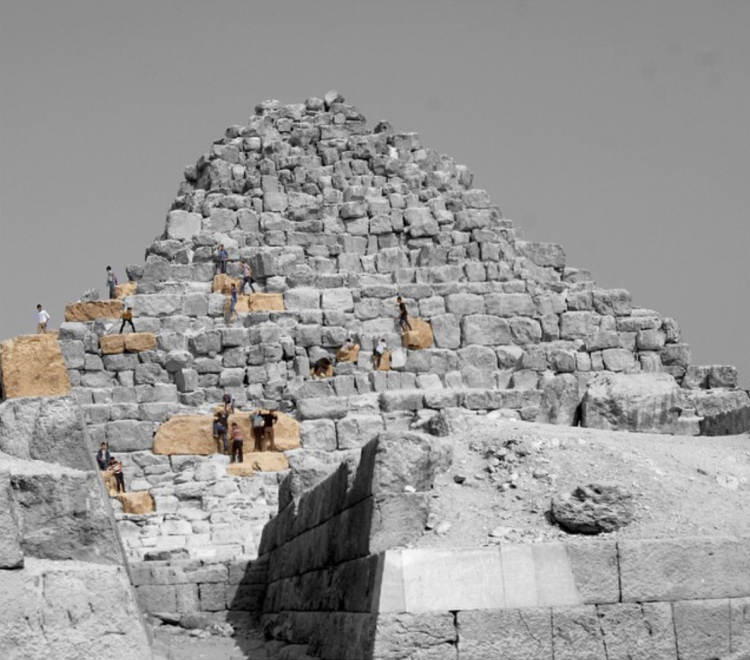Not All Egyptian Mummies Are Nobly Preserved

Resting in peace is not much of an option in the Northern Cemetery of the Cairo Necropolis. Egyptians, like many others, find peace in having a physical, spiritual site where they can visit and express their sorrow over their departed loved ones; it’s part of our culture. As an Egyptian studying abroad, my admiration for all Egyptian aspects grows ever deeper the longer I am away. After all, Egypt’s heritage remains amongst the world's most admired and highlights the country’s historic brilliance. Nevertheless, a number of families in Cairo are anticipating the end of their peaceful participatory practice since a highway construction project, which aims to connect Old and New Cairo together, was announced by the government in July this year.
Located on the street of Qansuh Al Ghuri, valuable architectural plateaus from the Mamluk era have been destroyed by trucks and abandoned by their nation in the name of development. The Egyptian people’s anger was expressed on social media platforms. Some were heart-broken about having to move their family members’ bodies elsewhere 48 hours before the cultural abuse took place, while others were upset to see their Old Cairo cultural heritage going to waste.
A nation’s development plan should not neglect history. Erasing the past is not development; it is destruction, which reminds me of UNESCO’s revolutionary rescue of the Abu Simbel and Philae Temple during the early 1960s. With the construction of the Aswan High Dam, a major step in Egypt’s development plan, a scientific and sustainable approach was taken to save our ancestors’ legacy; a great example that needs to be considered today.
With the increased population of Cairo, where there’s growth of 4 million in just ten years, the need for developing and reorganizing the infrastructure system is essential. However, the Egyptian government needs to see beyond the highway solution as this is not the first project involving their construction.
In March this year, Egyptologists and Google map images began to pick up visuals of two highways of eight lanes each across the pyramids of Giza in ancient Memphis. Although a suspended project during the 1990s, the Egyptian authorities thought it was time to resume the project in efforts to connect the west city of Sixth of October to the new east capital city of Cairo after building the biggest museum in the world, collecting all Egyptian antiquities. When expressing their displeasure with such project, former senior UNESCO official Said Zulficar and the UNESCO requested more detailed information about the infrastructure development concerning many. The UNESCO also expressed their intention to send in a monitoring mission. In response to their concerns, the current secretary-general of Egypt’s Supreme Council of Antiquities, Mostafa al-Waziri said, “The roads are very, very important for development, for Egyptians, for inside Egypt.” In addition, he indicated that the Egyptian authorities should not be doubted and that they will, as always, take good care of their cultural and historical sites. Last but not least, al-Waziri mentioned that only electric tourist buses will be allowed to drive on the new roads in an attempt to reduce pollution; a statement with unpredictable results - knowing that Egypt is still at the very early stage of introducing electric vehicles.
Infrastructure improvements in congested areas will do nothing but make the cities more congested. Ahmed, a 36-year-old man who lives in the west city of Sixth of October with his family, is very uncomfortable with the idea, “We initially moved here because the area was known for its tranquil atmosphere, it used to be a 100 % residential area.” Ahmed added that the area is now highly becoming industrial and commercial, with many shopping centers, restaurants, coffee shops, beauty salons, grocery stores and new tower constructions put in place, “I don’t think the construction of residential or non-residential towers in this area was ever allowed.” The lack of restrictions and policies strongly highlights Egypt’s desire to develop, even if it means ruining current residents’ quality of life.
Development should not entail the destruction of heritage, nature and life conditions. Instead, it should consolidate a nation’s strengths and aim to attain its societal, political, economic, environmental and infrastructural goals while showing the utmost respect towards people’s past, present and future lives. Before creating highways, the government should prioritize the development of the nation’s health system and educational structure, which are crucial to any strong community and society.







